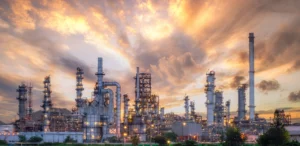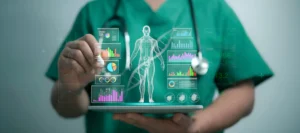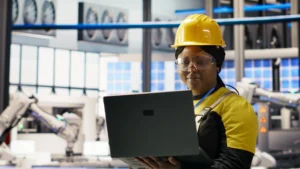Computer vision is perhaps one of the leading recent technical advances. After all, as the name suggests, it involves conferring to machines and computers the ability to “see”, with a series of advanced technological tools.
When applied to productive sectors, computer vision is an important step towards digital transformation. It opens doors to the development of new technologies and consolidates the incorporation of digital processes in a wide range of economic sectors, from healthcare to agriculture.
This post will explain how computer vision functions, what it is capable of doing, its impacts on digital transformation and how it can be applied.
Enjoy your reading!
What is computer vision?
Computer vision is a technology that, like many others, falls under the umbrella of artificial intelligence.
Based on principles from different fields of knowledge, computer vision replicates various functions of human sight using extremely advanced software and hardware for recognition, identification, detection, reconstruction and restoration of images.
In this way, computers and machines are able to “see”, that is, they can understand the visual world, by interpreting and extracting information from images they capture with cameras and sensors.
To make this possible, computer vision uses two other technologies that are derived from artificial intelligence: machine learning and specifically neural networks or deep learning.
Thus, in addition to reproducing certain aspects of human vision, computer vision can be even more precise, given that it is able to identify details that usually go unnoticed by an observer.
How computer vision functions
To better understand how computer vision functions it is important for us to first understand how human vision functions.
Human vision x computer vision
Seeing is a highly complex physiological process that involves countless structures of our organism. Sight is not limited to capturing light reflected by objects but encompasses a series of processes of identification and interpretation of this light by the brain.
In sum, the reflected light passes through the eyes, is captured by the retina, and is sent to the brain via the optic nerve. Once received, neurons process the image.
A similar process takes place in computer vision. In a machine, cameras and sensors play the role of the eyes. Embedded neural networks receive the images and using artificial intelligence algorithms extract information from them and classify it.
In computers, this process involves various layers, which range from recognition of basic aspects, such as colors and pixels to more complex analyses such as those of lines, contours and objects.
Machine learning and deep learning
As mentioned, computer vision is based on the technologies of machine learning and deep learning. It is important to note that, in both learning by a conventional machine and with deep learning, it is necessary for a system to be constantly fed with attributes, so that it can learn by means of repetition of patterns.
But neural networks are capable of “learning” many more details. This is because deep learning uses large volumes of data to detect and extract characteristics.
By working with a group of images it is possible to train a system, which comes to detect common characteristics and learn to differentiate objects, animals and people. It is a constant and cumulative process, each time that the system receives new information, it becomes “wiser”.
Thus, with computer vision, machines and computers can classify images, detect living beings and objects and recognize movements.
But how does this analysis function?
How the analysis of computer vision functions
When the system captures an image, it examines each pixel that shapes it, because they are the smallest elements that compose a digital image. Each color contains distinct information, in the form of a code.
The algorithm analyzes these factors and learns, coming to recognize images based on numeric values. This means that the system is able to identify patterns in images by analyzing these values, which allows the comparison of similar images.
This is where Convolutional Neural Networks (CNNs) come in. These are algorithms for deep learning that extract characteristics from the datasets of the images by applying filters. They then use layers of neural networks to recognize these images and classify them.
In sum, although they can vary according to the application and the objective, computer vision has some typical functions. These include:
- Acquisition of the image: cameras and sensors are used to capture images, which can be bi- or tri-dimensional. The machine intercepts the pixels to identify the intensity of the light and the colors, as well as aspects such as depth.
- Pre-processing: the system processes the image to assure the quality of the analysis. This involves steps such as reduction of noise, adjustment of contrast, and others.
- Extraction of characteristics: recognition of the mathematical characteristics of the image, such as textures, formats and movements. This is what allows machines to identify edges and corners for example.
- Detection and segmentation: this involves establishing the priority of the importance of each region of the image for the final processing.
- Processing: this is the step that classifies the object detected.
What can computer vision do?
As we saw, computer vision is derived from artificial intelligence. But what is the “intelligence” behind this technology? Computer vision uses deep learning to catalog static or moving images captured by cameras and sensors.
These neural networks extract common characteristics of the images that they analyze, detecting patterns that will facilitate the identification and classification of specific items, such as objects, faces or animals.
One example is the application of computer vision for facial recognition. At first the system is supplied with enough images of human faces so that the algorithms of the neural networks can learn to detect faces on their own.
This is only possible because of the Convolutional Neural Networks. They treat the images and extract spatial information, such as edges, depth and texture. The architecture of CNNs is inspired by the structure of neurons in our brain, more specifically by the visual cortex.
They involve various overlapping layers that analyze different parts of an image. The first layer is responsible for detecting basic characteristics such as pixels and vertical and horizontal lines.
The deeper layers have more complex functions and can identify elements such as shapes and edges. Together they generate a neural network that allows machines to identify faces, buildings, locations, numbers, and other things.
This is the type of process that allows computer vision to in fact be intelligent and determine if an image does or does not contain a certain object, person or desired characteristic.
Impacts of computer vision on digital transformation
Computer vision is a highly disruptive technology and has performed an important role in digital transformation, particularly in relation to Industry 4.0. Whether in the food, textiles, automobile or healthcare sector, industry has increasingly benefitted from intelligent systems with high capacity for processing, expanding the options for use of computer vision.
Monitoring systems for recognizing patterns and identifying errors have been used to complement human labor. They provide greater precision and efficiency in a production chain by capturing crucial details that can go unnoticed.
In addition, computer vision collaborates with a greater computerization of processes, which increases efficiency and stimulates the development of new technologies that help improve productivity and reduce losses.
A key element in the digital transformation of industry, computer vision can help lower costs and improve processes, and stands out by offering an important competitive advantage for certain industrial sectors.
Applications of computer vision
Computer vision is at the foundation of some technologies that have become more common in recent years and that should become dominant in coming decades.
Some applications of this technology are:
Autonomous vehicles
Driverless cars should soon become a reality, especially in countries like the United States where testing is being conducted daily. To drive safely, these vehicles use computer vision technology to recognize the trajectory and obstacles in the path, whether they are people, animals or other vehicles.
Marketing
In the era of online sharing, when billions of images are posted daily, many companies have used computer vision to recognize non-textual mentions of their brands, such as logos or other visual indications in photos posted on social networks. This opens a broad range of new possibilities for marketing campaigns.
Safety
Facial recognition systems are being used in many cities of the world to bolster public safety. They assist in the search for criminal suspects, in monitoring events, and to determine if people are carrying prohibited objects for example.
The same technology is being applied to confirm operations in the financial sector, on social networks and on a series of applications that strive to add an extra layer of security.
Public services
It is not just facial monitoring that is being used throughout the world. The recognition of vehicles or the simple monitoring of traffic are examples of applications of computer vision by government.
Industry
Many productive sectors, such as food, textiles or automobiles already use computer vision to assist in quality control, to count items, identify equipment problems, and other tasks. Monitoring systems can point to mistakes and indicate to production line workers the areas that deserve attention.
Military use
Defense systems also benefit from computer vision. While it can be used to identify enemy units or track projectiles in flight, an example more pertinent to Brazil is the use of drones to monitor the country’s land borders, particularly in remote regions. It can also be used to accompany deforestation and forest fires.
Healthcare
Companies in the healthcare field are also benefiting from computer vision, using the technology to process images from medical exams, such as radiography, tomography and ultrasound, and in the analysis of microscopy and other procedures.
The algorithms of neural networks are able to analyze images and identify patterns that can indicate anomalies that should be investigated, thus improving medical diagnoses. They also help conduct more precise and secure surgical procedures.
Agriculture
The agricultural sector is one of those that most benefits today from computer vision. The technology can be used in various ways, such as controlling planting, robotization of harvest (by distinguishing green and ripe fruits), to identify weeds and the presence of animals, manage fertilizer use, control pests, and even to track herds and control animal weight.
Computer vision Systems: how CERTI operates
The CERTI Foundation specializes in the development of computer vision systems that can be applied in different sectors. One of the most prominent examples of this competence is found in agriculture.
In partnership with Hórus Aeronaves, a company that develops and sells products and services for capturing and processing aerial images using drones, a system was developed that is based on artificial intelligence to verify the presence of weeds in soybean plantations.
The project involved training computer vision models based on algorithms of artificial intelligence. The objective was to allow the system to replicate with high fidelity the visual identification of weeds which, until then, was conducted by specialized professionals.
During the 9-month Project, CERTI and Horus developed and applied the parameters that would be used by the system involving artificial intelligence and computer vision. Based on a set of data from soybean farms in a region, it was possible to develop an algorithm specialized in the identification of weeds that can also be applied to other cultivation tasks.
The same system can be used by Horus to train AI models for various contexts in agriculture, such as identifying pests, the presence of animals in crops and for herd control.
Conclusion
Computer vision is an important motivator of digital transformation in industry and is present in some of the main innovations that should be part of our daily lives in coming years, especially because of the ease with which it can be applied in different contexts, from the analysis of images from medical exams to pest control in agriculture.
If you would like to learn how computer vision can be applied at your company, contact CERTI and speak with one of our specialists!







